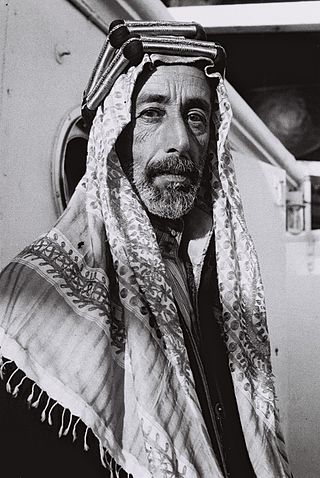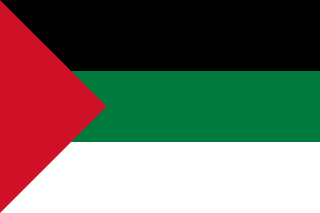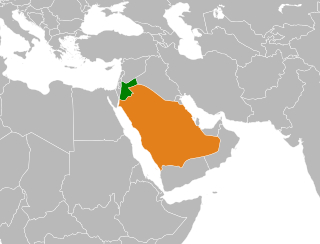
The history of Saudi Arabia as a nation state began with the emergence of the Al Saud dynasty in central Arabia in 1727 and the subsequent establishment of the Emirate of Diriyah. Pre-Islamic Arabia, the territory that constitutes modern Saudi Arabia, was the site of several ancient cultures and civilizations; the prehistory of Saudi Arabia shows some of the earliest traces of human activity in the world.

Abdulaziz bin Abdul Rahman Al Saud, known in the Western world mononymously as Ibn Saud, was the founder and first king of Saudi Arabia, reigning from 23 September 1932 until his death in 1953. He had ruled parts of the kingdom since 1902, having previously been Emir, Sultan, and King of Nejd, and King of Hejaz.

Taif is a city and governorate in the Province of Makkah in Saudi Arabia. Located at an elevation of 1,879 m (6,165 ft) in the slopes of the Hijaz Mountains, which themselves are part of the Sarat Mountains, the city has a population of 563,282 people in 2022, making it one of the most populous cities in the kingdom.

Harry St John Bridger Philby, CIE, also known as Jack Philby or Sheikh Abdullah, was a British Arabist, advisor, explorer, writer, and a colonial intelligence officer who served as an advisor to King Abdulaziz ibn Saud, the founder of Saudi Arabia.

The Sharif of Mecca was the title of the leader of the Sharifate of Mecca, traditional steward of the Islamic holy cities of Mecca and Medina. The term sharif is Arabic for "noble", "highborn", and is used to describe the descendants of Hashim ibn Abd Manaf.

Ali bin Hussein bin Ali al-Hashimi, was King of Hejaz and Grand Sharif of Mecca from October 1924 until he was deposed by Ibn Saud in December 1925. He was the eldest son of King Hussein bin Ali and a scion of the Hashemite family. With the passing of the kingship from his father he also became the heir to the title of caliph, but he did not adopt the office and the style of caliph.

The Hashemite Kingdom of Hejaz was a state in the Hejaz region of Western Asia that included the western portion of the Arabian Peninsula that was ruled by the Hashemite dynasty. It was self-proclaimed as a kingdom in June 1916 during the First World War, to be independent from the Ottoman Empire, on the basis of an alliance with the British Empire to drive the Ottoman Army from the Arabian Peninsula during the Arab Revolt.

The Battle of Mecca occurred in the Muslim holy city of Mecca in June and July 1916. On June 10, the Sharif of Mecca, Hussein bin Ali, the leader of the Banu Hashim clan, started a revolt against the Ottoman Caliphate from this city. The Battle of Mecca was part of the Arab Revolt of World War I.
The Battle of Jeddah or the siege of Jeddah took place in 1925, as part of the Abdulaziz Ibn Saud's campaign to conquer the Kingdom of Hejaz. Jeddah was the last major stand of the Hashemites against the Saudis.

The unification of Saudi Arabia was a military and political campaign in which the various tribes, sheikhdoms, city-states, emirates, and kingdoms of most of the central Arabian Peninsula were conquered by the House of Saud, or Al Saud. Unification started in 1902 and continued until 1932, when the Kingdom of Saudi Arabia was proclaimed under the leadership of Abdulaziz, known in the West as Ibn Saud, creating what is sometimes referred to as the Third Saudi State, to differentiate it from the Emirate of Diriyah, the First Saudi State and the Emirate of Nejd, the Second Saudi State, also House of Saud states.
The Capture of Mecca took place on 5 December 1924 in Mecca, as part of the Saudi conquest of the Kingdom of Hejaz by King Abdulaziz Ibn Saud of the Sultanate of Nejd. The Hejaz region was ruled as a kingdom under King Hussein bin Ali of the Hashemite family.
Sultan bin Bajad bin Humaid al-'Utaybi was the Sheikh of the Otaibah tribe and one of the prominent leaders of the Ikhwan movement in the Arabian Peninsula. This tribal army supported King Abdulaziz in his efforts to unify Saudi Arabia between 1910 and 1927.

The Sharifate of Mecca or Emirate of Mecca was a state, non-sovereign for much of its existence, ruled by the Sharif of Mecca. A sharif is a descendant of Hasan ibn Ali, Muhammad's grandson. In Western sources, the prince of Mecca was known as Grand Sherif, but Arabs have always used the appellation "Emir".

The Ikhwan raids on Transjordan were a series of attacks by the Ikhwan, irregular Arab tribesmen of Najd, on the Emirate of Transjordan between 1922 and 1924. The repeated Wahhabi incursions from Najd into southern parts of his territory were the most serious threat to Emir Abdullah I's position in Transjordan. The emir was powerless to repel these raids by himself, thus the British maintained a military base, with a small air force, at Marka, close to Amman. The British military force was the primary obstacle against the Ikhwan, and ultimately helped Abdullah to secure his rule over Transjordan.

The Ikhwan revolt was an uprising in the Arabian Peninsula from 1927 to 1930 led by the Ikhwan. It began in 1927, when the tribesmen of the Otaibah, Mutayr and Ajman rebelled against the authority of Ibn Saud and engaged in cross-border raids into parts of Transjordan, Mandatory Iraq and the Sheikhdom of Kuwait. The relationship between the House of Saud and the Ikhwan deteriorated into an open bloody feud in December 1928. The main instigators of the rebellion were defeated in the Battle of Sabilla, on 29 March 1929. Ikhwan tribesmen and troops loyal to Abdulaziz clashed again in the Jabal Shammar region in August 1929, and Ikhwan tribesmen attacked the Awazim tribe on 5 October 1929. Faisal al-Duwaish, the main leader of the rebellion and the Mutair tribe, fled to Kuwait in October 1929 before being detained by the British and handed over to Ibn Saud. Al-Duwaish would die in Riyadh on 3 October 1931 from an apparent heart condition. Government troops had finally suppressed the rebellion on 10 January 1930, when other Ikhwan rebel leaders surrendered to the British. In the aftermath, the Ikhwan leadership was slain, and the remains were eventually incorporated into regular Saudi units. Sultan bin Bajad, one of the three main Ikhwan leaders, was killed in 1931, while Al-Duwaish died in prison in Riyadh on 3 October 1931.
The Saudi conquest of Hejaz or the Second Saudi-Hashemite War, also known as the Hejaz-Nejd War, was a campaign by Abdulaziz al-Saud of the Saudi Sultanate of Nejd to take over the Hashemite Kingdom of Hejaz in 1924–25, ending with conquest and incorporation of Hejaz into the Saudi domain.

Jordan–Saudi Arabia relations are characterized by mutual recognition and exchange of embassies.
The First Saudi–Hashemite War, also known as the First Nejd–Hejaz War or the al-Khurma dispute, took place in 1918–19 between Abdulaziz Ibn Saud of the Emirate of Nejd and Hasa and the Hashemites of the Kingdom of Hejaz.

The Battle of Turubah was fought on May 26, 1924, between the forces of Hussein bin Ali, under the command of his son Abdullah bin Al-Hussein, and forces under the command of Abdulaziz bin Abdul Rahman Al Saud. It was a larger part of the Hejaz-Nejd War, as well as the Al-Khurma dispute. The battle resulted in the end of Hussein's hopes to expand into the Arabian peninsula, as well as opening the way for Ibn Saud to fortify his own control over the region, which in turn would eventually lead to the creation of Saudi Arabia.

The Declaration of theUnification of Saudi Arabia was officially announced by Prince Faisal bin Abdulaziz, the Viceroy of Hejaz and future monarch on behalf of King Abdulaziz ibn Saud on September 23, 1932, at 9:00 am from al-Hamidiyah Palace in Mecca. Faisal read out the Royal Decree No. 2716 issued by Abdulaziz ibn Saud on September 18, 1932, that renamed the Kingdom of Hejaz and Nejd and its annexes as the Kingdom of Saudi Arabia.













